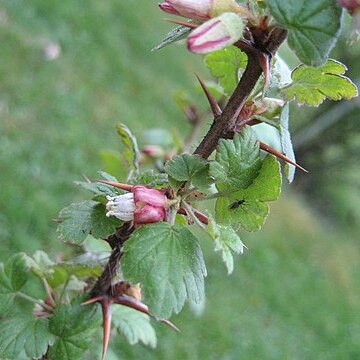Shrubs 1-3 m tall. Branchlets puberulent when young; nodal spines 3, verticillate, stout, 1-3 cm; internodes sparsely and minutely prickly or stalked glandular. Buds ovoid; scales scarious. Petiole 2-3.5 cm, puberulent or sparsely glandular hairy; leaf blade broadly ovate, 1.5-3 × 2-4 cm, puberulent, more densely so along veins, glabrescent, base subtruncate to cordate; lobes 3-5, margin coarsely obtusely serrate or doubly serrate, apex obtuse; terminal lobe subequaling or slightly longer than lateral ones. Flowers axillary, solitary or 2 or 3 in short racemes, bisexual; bracts paired, broadly ovate to ovate-triangular, 2-3 mm, 3-veined; pedicel 5-8 mm, glabrous or sparsely glandular hairy. Calyx greenish or reddish brown, pubescent and sparsely stalked glandular, rarely glabrous; tube campanulate, 5-6 mm, glabrous adaxially; lobes reflexed, erect in fruit, oblong to ligulate, 5-7 mm. Petals white, elliptic to oblong, rarely obovate, 2.5-3.5 mm. Stamens ca. 4-5 mm; anthers exserted, ovoid, apex with cupular nectary. Ovary glabrous, rarely pubescent, usually stalked glandular. Style clavate, divided for almost 1/2 its length. Fruit purple, globose to ellipsoid, 1.2-1.5 × 1-1.2 cm, usually stalked glandular. Fl. Apr-Jun, fr. Jun-Sep.
More
A shrub. It has many branches. It grows about 2 m high. The stem is prickly. There are 1-3 spines at each node. The leaves have long stalks. They are rounded with blunt teeth. They are slightly hairy. The flowers occur singly. They are white and bell shaped. The fruit is a berry. It is oval and dull red. It has hairy glands over it.
Broad-leaved or coniferous forests, undergrowth of sparse forests on sunny slopes, forest margins, foothills, grasslands in ravines, river banks; at elevations from 1,000-3,900 metres. Dry, open slopes in Nepal.
More
It is a temperate to subtropical plant. In Nepal it grows between 3200-3600 m altitude. It grows on dry, open slopes. In Sichuan and Yunnan.

